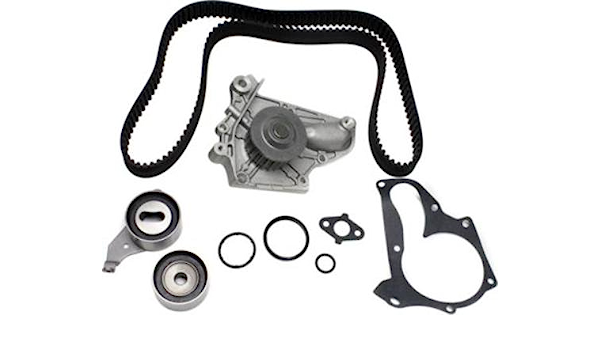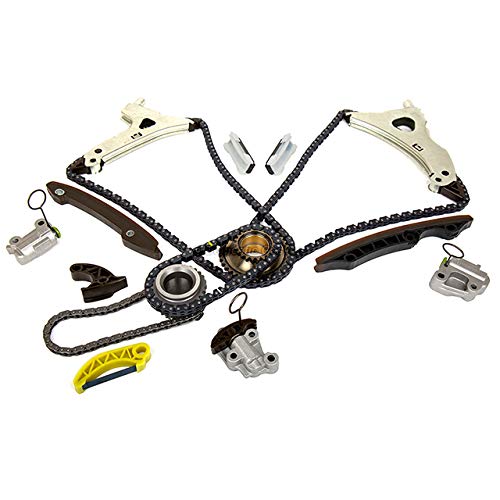Introduction:
A timing belt or timing chain is a crucial component in an internal combustion engine that synchronizes the rotation of the engine’s camshaft(s) and crankshaft. The camshaft controls the opening and closing of the engine’s valves, while the crankshaft converts the up-and-down motion of the pistons into rotational motion.
and closing of the engine’s valves, while the crankshaft converts the up-and-down motion of the pistons into rotational motion.
The camshaft and crankshaft are vital components of the engine’s valve and piston operation. The camshaft is responsible for controlling the opening and closing of the engine’s valves. It has lobes or cam profiles that push against the valves’ lifters, causing them to open and close at specific times during the engine’s operation. The timing of these valve openings and closings is critical for the engine’s proper functioning, as it determines the intake of air-fuel mixture and the expulsion of exhaust gases.
On the other hand, the crankshaft converts the up-and-down motion of the pistons into rotational motion, transmitting power to the drivetrain. It connects to the pistons through connecting rods, and as the pistons move up and down, they transfer their linear motion to the crankshaft, which converts it into a rotating motion.
To synchronize the camshaft(s) and crankshaft, the engine utilizes a timing belt or timing chain.
Timing Belt:
A timing belt is a toothed belt made of rubber with embedded fibers. It runs between the camshaft(s) and the crankshaft, with toothed sections that engage with corresponding gears or sprockets on the camshaft(s) and crankshaft.
The timing belt’s teeth are precisely designed to match the tooth count on the camshaft and crankshaft gears, ensuring a specific ratio and timing between their rotations. As the crankshaft rotates, it transfers motion to the timing belt, which, in turn, rotates the camshaft(s) at precisely timed intervals. This synchronization is crucial because it ensures that the engine’s valves open and close at the correct time in relation to the piston’s position.
Example 1:
Toyota Car (Timing Belt) Many Toyota vehicles, especially those equipped with four-cylinder engines, commonly use timing belts. Let’s consider a Toyota Camry with a 2.4L four-cylinder engine as an example.

The timing belt in the Toyota Camry is typically made of rubber with embedded fibers, designed to be durable but still subject to wear over time. The manufacturer may recommend replacing the timing belt around every 70,000 miles or 110,000 kilometers. It’s essential to consult the specific vehicle’s owner’s manual or contact a Toyota dealership to obtain an accurate replacement recommendation.
If the timing belt on this Toyota Camry were to break while the engine is running, it could cause severe engine damage. Since the timing belt keeps the camshaft and crankshaft in sync, if it fails, the valves may collide with the pistons. This collision can result in bent or broken valves, damage to the cylinder head, and potential harm to the pistons, connecting rods, and crankshaft. Repairing this kind of damage can be quite expensive, often requiring a complete engine overhaul or replacement.
The cost of timing belt replacement for a Toyota Camry can vary based on factors such as the region, labor rates, and whether you choose an original equipment manufacturer (OEM) belt or an aftermarket belt. On average, the cost may range from €300 to €700 for parts and labor.
Timing Chain:
A timing chain is a metal chain that performs the same function as a timing belt but with a different construction. It consists of metal links connected together and is lubricated by the engine’s oiling system.
Similar to the timing belt, the timing chain runs between the camshaft(s) and the crankshaft, engaging with gears or sprockets on these components. As the crankshaft rotates, it drives the timing chain, which, in turn, rotates the camshaft(s) at the proper timing. The timing chain’s metal construction offers greater durability and is less prone to stretching or wear compared to a timing belt.
Example 2:
Mercedes Car (Timing Chain) Mercedes-Benz vehicles typically use timing chains, which are more durable than timing belts and require less frequent replacement. Let’s consider a Mercedes C-Class with a 3.0L V6 engine as an example.

The timing chain in the Mercedes C-Class is constructed with metal links, making it more robust and resistant to wear compared to a timing belt. Mercedes-Benz generally recommends periodically inspecting the timing chain and its components and replacing them only if there are signs of wear, damage, or abnormal noise. The replacement interval may not be specified by mileage or kilometers.
While timing chains are more durable than timing belts, they can still experience wear over time. If a timing chain were to break or skip teeth due to excessive wear, it could lead to the same consequences as with a timing belt failure. The loss of synchronization between the camshaft and crankshaft can result in potential valve and piston collision, leading to significant engine damage.
The cost of timing chain replacement in a Mercedes can vary widely depending on the model, engine design, and other factors. Typically, it can range from €1,000 to €3,500 or even more, depending on the specific circumstances and parts required.
Both the timing belt and timing chain ensure the proper synchronization between the camshaft(s) and crankshaft, allowing the valves to open and close at the precise moments during the engine’s operation. This synchronization is crucial for the engine’s overall performance, efficiency, and smooth operation.
It’s important to note that the timing belt or timing chain must be maintained in good condition, regularly inspected, and replaced according to the manufacturer’s recommended intervals. Neglecting timely replacement can lead to the belt or chain wearing out, breaking, or skipping teeth, which can result in severe engine damage due to valve and piston collision.
Conclusion:
Understanding the role of timing belts and timing chains in engine operation is crucial for car owners. Regular inspection, maintenance, and timely replacement of these components are vital to prevent potential engine failures and expensive repairs. By taking proactive measures to care for your timing belt or timing chain, you can ensure the longevity and reliability of your engine. The replacement interval for a timing belt is generally around 70,000 miles or 110,000 kilometers, while timing chains require periodic inspection and replacement only if necessary. Failure to replace a timing belt or a worn timing chain can lead to severe engine damage, and the cost of repair can vary depending on the vehicle’s make, model, and associated factors.
Contact us today to schedule an appointment and have your timing belt or timing chain inspected. Our knowledgeable technicians will assess the condition of your timing components, looking for signs of wear, damage, or potential issues. If replacement is necessary, we use high-quality timing belts or timing chains to ensure optimal performance and reliability.
Remember, neglecting the maintenance of your timing belt or timing chain can lead to severe engine damage, resulting in costly repairs or even engine replacement. Don’t wait until it’s too late—take proactive steps to protect your engine’s health.

